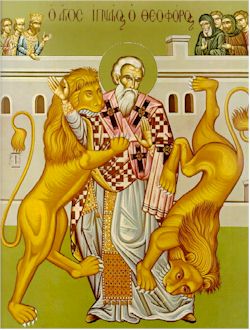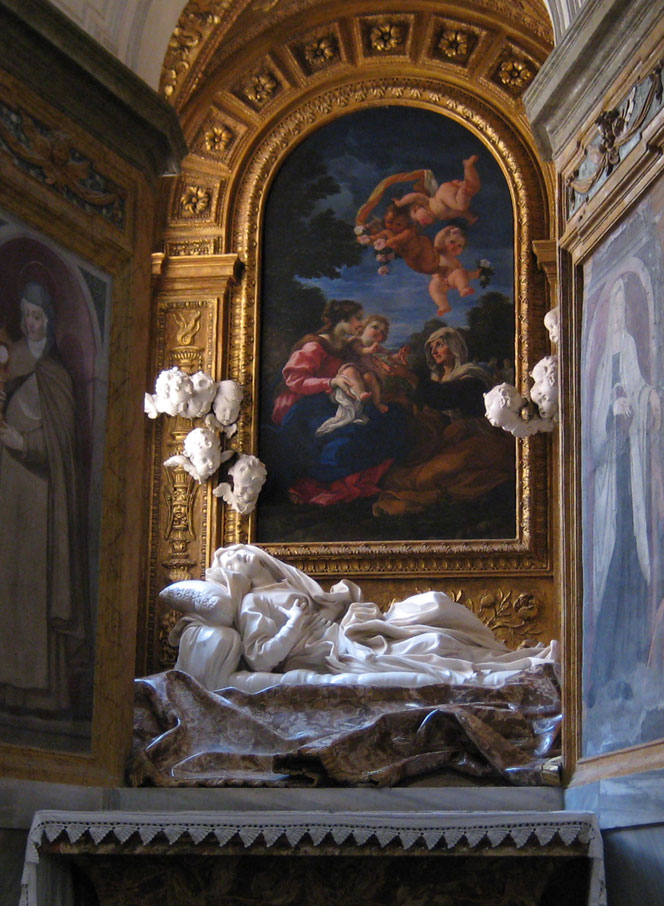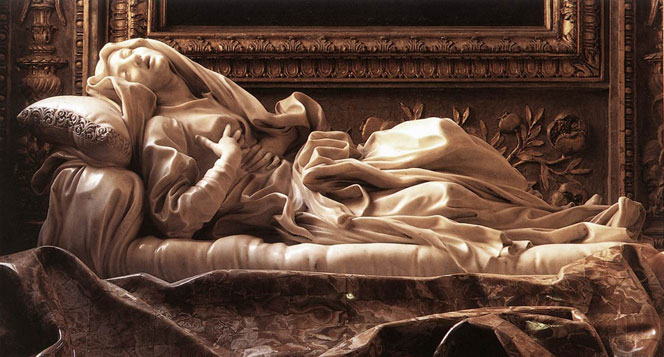My Roman Curia calendar today shows that it is the Feast of Bl. Ludovica Albertoni (+31 Jan 1553). My (Novus Ordo – 2005) Martyrologium Romanum listed her yesterday, the day of her death, otherwise known as her dies natalis, her birthday into heaven.
Either way, here is her entry in the Martryologium:
Romae, beatae Ludovicae Albertoni, quae, filiis christianis moribus pie institutis, post viri obitum, Tertio Ordini Sancti Francisci adscripta, pauperibus auxilium attulit, ex divite pauperrima facta.
Let’s see your own flawless and yet smooth renderings of the Latin.
Bl. Ludovica wanted to remain a virgin but at the behest of her family, married. She was widowed at 33 and became a Franciscan Tertiary. She often had spiritual ecstasies and levitated.
Ludovica is rather like St. Francesca of Rome, who as a widow became Benedictine Oblate in the house that she had earlier established. As a married woman, she used her family’s wealth to help the poor. When was first in Rome, I lived in her family house in Trastevere, the Palazzo Ponziani, then a quasi-religious residence for young men, now converted into a rather nice hotel. In that palazzo there is a chapel and the room where she died.
Bl. Ludovica is someone you should visit when you are in Rome, in her tomb of the church in Trastevere San Francesco a Ripa. It isn’t too far from Santa Cecilia. The great sculptor Gian Lorenzo Bernini made her monument, and it is one of the great sculptures in Rome, reminiscent of his St. Theresa in Ecstasy in S. Maria della Victoria across town. He made this late in his life.
Here are a couple pics. The statue depicts her in extremis, in her death throes, simultaneously her last breaths and a spiritual ecstasy.
Before someone asks, the painting is of St. Ann and the Virgin by Giovanni Battista Gaulli.
I remember the first time I saw this. It was in my earliest days studying Latin with Fr. Foster in the 80’s. I wandered into the church not knowing that this was within.
 Of course in the older, traditional calendar, today is the Feast of St. Ignatius of Antioch, bishop and martyr. His body is also in Rome, in the stupendous San Clemente.
Of course in the older, traditional calendar, today is the Feast of St. Ignatius of Antioch, bishop and martyr. His body is also in Rome, in the stupendous San Clemente.
His death was gruesomely beautiful. Gruesome in its method, beautiful in its holiness.
In Matins in the Breviarium Romanum, we read:
Ignatius, chosen to be the second successor of Peter as bishop of Antioch, was accused of being a Christian during Trajan’s reign and condemned to be sent to the beasts in Rome. As he was being brought from Syria in chains, he kept teaching all the cities of Asia which he went through, exhorting them as a messenger of the Gospel and instructing the more distant ones by his letters. In one of these letters, which he wrote to the Romans from Smyrna while he was enjoying Polycarp’s companionship, among other matters he said this about his own death sentence: “O helpful beasts that are being made ready for me! when will they come? When will they be sent out? When will they be allowed to devour my flesh And I hope that they will be made the more fierce, lest by chance, as has happened in the case of others, they may fear to touch my body. Now I am beginning to be Christ’s disciple. Let fire, crosses, beasts, the tearing apart of my limbs, the torment of my whole body and all the sufferings prepared by the devil’s art be heaped upon me all at once, if only I may attain Jesus Christ. When he had arrived in Rome, he heard the lions roaring and, burning with desire for martyrdom, he burst out, “I am the wheat of Christ; let me be ground by the teeth of the beasts so that I may be found pure bread.” He suffered in the eleventh year of Trajan’s reign.
And from his Letter to the Romans, 3:
“Only request in my behalf both inward and outward strength, that I may not only speak, but [truly] will, so that I may not merely be called a Christian, but really found to be one. For if I be truly found [a Christian], I may also be called one, and be then deemed faithful, when I shall no longer appear to the world. Nothing visible is eternal. ‘For the things which are seen are temporal, but the things which are not seen are eternal’ [2 Cor 4:18]. The Christian is not the result of persuasion, but of power. When he is hated by the world, he is beloved of God. For says [the Scripture], ‘If ye were of this world, the world would love its own; but now ye are not of the world, but I have chosen you out of it: continue in fellowship with me’ [John 15:19].”




































“The Christian is not the result of persuasion, but of power. When he is hated by the world, he is beloved of God”
This is such sound wisdom for all Christians. It provides an immovable signpost as to whether our Faith and Doctrine are sound.
And it is reason #1 why I am concerned about the pontificate of Frances. I pray for him that he may be a good shepherd to us and in so doing please Christ rather than the world.
Romae, beatae Ludivicae Albertoni, quae, filiis christianis moribus pie institutis, post viri obitum, Tertio Ordini Sancti Francisci adscripta, pauperibus auxilium attulit, ex divite pauperrima facta.
In Rome, the feast of blessed Ludovica Albertoni, who, having grounded her children in Christian ways and having been enrolled in the Third Order of Saint Francis after the death of her husband, rendered aid to the poor out of her wealth, and so became very poor herself.
Was her name misspelled in the Martyrologium?
It’s worth noting that St. Ignatius was the first to use the word “catholic” to describe the Church. Do you suppose this usage predates the use of the word “christian”?
Father, you might like the book “Learning Christ: Ignatius of Antioch and the Mystery of Redemption,” written by Gregory Vall. It’s very, very good.
Is Louise the English name for Ludovica?